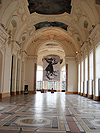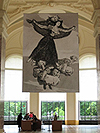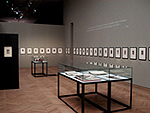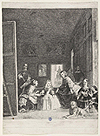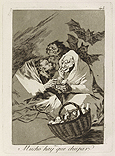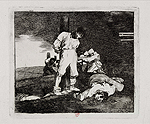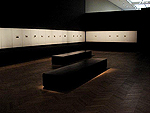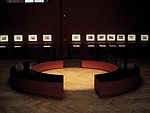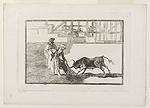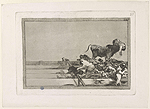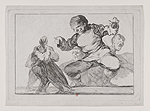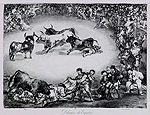The browser will either open the file, download it, or display a dialog.
|
Goya Graveur |
|||
|
Almost thirty years after the Petit Palais hosted its first exhibition of Goya's prints, this newly renovated museum outdid itself with one of the most captivating shows in Paris during the spring and summer season. The unusually long lines that trailed from its entrance are quite commonplace across the street at the Grand Palais, where the Marie Antoinette exhibit was on display, but most visitors often skip this smaller museum all together. For Goya Graveur however, both tourists and the intellectual elite came in droves to see not only the works of art, but also their clever and unusual installation (figs. 1, 2). Curated by Maryline Assante di Panzello, Simon Andre-Duconchat and Juliet Wilson-Bareau, the use of striking colors such as red brick, dark brown, golden yellow and soft blue, taken from the artists’ color palette in his famous painting “Los Fusilamientos del 3 de Mayo” (The Shootings of May 3rd 1808) is more audacious here than in other recent Parisian exhibits and makes for a more rewarding visual experience. The well-known provenance of the pieces also plays a valuable role in attracting visitors as the majority of the prints in the exhibition are from two of the most famous French print collections: the frères Dutuit (Eugène, 1807-1886 and Auguste, 1812-1902) and the legendary fashion millionaire, Jacques Doucet (1853-1929). |
|||
|
Simon Andre-Duconchat, a Ph.D. candidate in art history at the Sorbonne University and one of the main forces behind the conception and creation of the show, pointed out that these two collections have never before been combined. In the 1980s exhibition, Gravures de Goya de la collection Dutuit, the museum focused on its own collection, based primarily on the donation made by the Dutuit brothers who had given an extremely rare first edition of the Tauromaquia series, plus a number of trial proofs, to the Ville de Paris in 1902. Combining these works with Los Desastres de la Guerra et Los Disparates from the Doucet collection, now at the Institut nationale d’histoire de l’art, and a rare series of Los Caprichos from the Bibliothèque nationale, proved to be an innovative approach, enabling the curators to select a much larger presentation of works than ever before, totaling more than 200 prints. |
|||
|
For Andre-Duconchat, one of the crucial elements to be noted is the difference in the collectors’ perception of the artist’s work. For Eugène and Auguste Dutuit, Goya's prints were purchased as the chronological conclusion to their collection of eighteenth-century art, whereas Jacques Doucet saw them as a bridge between traditional art and the modern era; when he decided to sell his collection of classic art in order to direct his energy towards the avant garde in 1912, he kept Goya's prints as part of his Cabinet d’estampes modernes of around 10,000 works. With these two complementary collections of Goya's prints, it seemed a natural idea to house the exhibit in the Petit Palais, which was originally built in 1900 for the Exposition Universelle, and was at one time designated to house an official Print Museum. Various collectors participated in donating a variety of works to create a foundation that would offer visitors a comprehensive history of printmaking. The museum opened its doors to the public in 1908, and unfortunately did not survive as an independent entity, but the donations have remained in the museum's holdings ever since. |
|||
|
For this particular exhibit at the Petit Palais, Goya was presented as an artist of la lumière, referring to his use of light, but also to his role as an artist of the Enlightenment. This was an original concept since it was one way of contextualizing the artist and his work while simultaneously attempting to explain how his use of light was symbolically linked to the period in which he was creating. The timing of the exhibit also coincides with the bicentenary of Napoleon’s invasion of Spain and the dramatic events that led the Spanish people into war, as well as the 200th anniversary of Goya's two monumental paintings from May 1808, both of which have now been cleaned and restored. This particular reference was emphasized in the installation through the partial reconstruction of The Massacre of the People in 1808, painted in 1814, which further gave rise to his series of prints, The Disasters of War, which were exhibited in the gallery adjacent to this reconstruction. In the most carefully developed ways, the organizers of the show continually tried to reveal how the prints and social history were interrelated. |
|||
|
Maîtres |
|||
|
His first dated print, done at the age of 30, was Exodus to Egypt (1774), which demonstrates quite a traditional and linear treatment, similar to that found in Giovanni Domenico Tiepolo’s work. The two artists became friends when G. D. Tiepolo’s father, Giambattista Tiepolo, worked at the court of King Charles III. Soon after, Goya would begin to use more cross-hatching in his work, so that by 1780, in his Portrait de St Francois de Paule, one of his first large-scale works, we can see the development of his technique. |
|||
|
The Velasquez series, Goya’s first series to be published for sale, emphasized the way that he used his intense study of an earlier master to his own advantage which proved to be quite a challenge for the young printmaker (fig. 3). This monumental undertaking would enable him to forge his artistic education in a self-guided fashion. One of the most interesting pieces of this series is Las Meninas, dated between 1778-1785 (fig. 4). Although his goal was to create an aquatint, he allowed the plate to sit in the acid for a prolonged period of time, ruining the plate. The trial proof on display in the current exhibit is extremely rare, one of the few printed before the aquatint was applied. |
|||
|
Los Caprichos |
|||
|
Fearing punishment from the government, Goya retracted the series only days after he offered it for sale. Ironically, Manuel Godoy, the Spanish prime minister who took over after Charles IV abdicated the throne, had his own personal copy of Los Caprichos bound in exceptional red leather. This rare copy, from the first edition and now in the collection of the Institut nationale d’histoire de l’art, is on display in a glass case in the center of the room (fig. 3). The series of prints on the wall belonged to Vivant Denon, Ministre des arts under Napoleon and was acquired by the Bibliothèque nationale in 1827. |
|||
|
L’Atelier |
|||
|
On the adjacent wall were a series of images showing the various stages of creation for Estan calientes (They are hot), the popular image of gluttonous monks from Los Caprichos. Beginning with the original preparatory drawing, followed by a red ink drawing which was used to position the aquatint, we then see the image transferred onto the copper plate, this particular one having been steel-plated in order to prolong the quality of its impression. Then there were two states of the etching: first with the aquatint added, but before the burnishing has been done, bearing the inscription “estan calientes” in the lower margin; second the final version of the etching with aquatint and burnishing and the title in the margin. The unusual display of each step of printmaking enabled the viewer to better understand the process of Goya’s technique. |
|||
|
The use of magnifying glasses, placed on top of the cases to help view the artist’s work, proved to be problematic on opening night when some visitors left them directly focused on the etchings. Shortly afterwards, a guard was placed nearby to displace the glasses so that light would not damage the prints. |
|||
|
Tres de Mayo and Los Desastres de la Guerra |
|||
|
As a sign of his dedication to his art and his denunciation of the atrocities of the war, Goya sacrificed two large copper plates and cut them into four smaller plates around 1810, during a difficult time when he was not able to purchase new copper on a regular basis. In the first state of Y no hai remedio, (There is no remedy) Goya uses etching and dry point to evoke the darkness of the execution scene in which Spanish resistance fighters are bound and blindfolded, and then killed (fig. 6). But what was most effective in this section of the exhibition was the installation. Within a huge space, Los Desastres de la Guerre was positioned on the walls all around the room, with the central space of the gallery reserved for a circular bench where visitors could observe—in silence—the entire sequence of prints. This evocative installation became a memorial to the dead, a silent witness to the unending disaster that is war (fig. 7). |
|||
|
La Tauromaquia |
|||
|
Los Disparates (Proverbes) |
|||
|
Lithography and Goya’s Move to France |
|||
|
Upon Goya's death in 1828, the artist was revered for his originality and his imagination, leaving a lasting impression on the romantic artists of the nineteenth century; this theme was explored in the last rooms of the exhibit. From Delacroix’s figures for Faust to Meissonier's lithograph entitled Nightmare for Le Charivari in 1834, both artists clearly derived their inspiration from Los Caprichos. Also of interest are the various copies by Achilles Devéria, in his series of lithographs from 1824, and Maurice Sand in his drawings from 1838. Goya's work was also admired by artists from the latter half of the nineteenth century, as seen in Félix Buhot's haunting frontispieces for l'Illustration nouvelle (1877) and Zigzags d'un curieux (1888) as well as Odilon Redon'seerie Hommage à Goya (1885) and Variations, Démon guettant (1907). There can be little doubt that later generations of printmakers, when they had the opportunity to see and understand Goya’s prints, were able to find ideas that they could use in their own work. None did this better than Edouard Manet, whose etchings not only rely on Goya’s strategies for positioning figures in unusual spatial relationships, but also contributed to the strong cult of French Espagnolisme that emphasized Goya’s art as one of its central fascinations. |
|||
|
The large scale of Goya Graveur and its exemplary installation made it one of the most educational exhibits in Paris; its audacious focus on printmaking alone also made it one of the most relevant. Avid print collectors and art historians alike can attest that there is a discrepancy in the importance of prints to paintings in the exhibition programs of most museums. Hopefully the overwhelming success of this show among all age groups will lead to others like it in the near future. To those who were fortunate to see the actual installation, this exhibition will remain a model for how to make prints accessible to the public, and demonstrate the importance of historical context in understanding the work. |
|||
|
Sabina Fogle with Gabriel P. Weisberg and Janet Whitmore |
|||


